Civil Engineering: Contract Types, Project Admin & Key Features
VerifiedAdded on 2023/04/06
|27
|5563
|436
Homework Assignment
AI Summary
This assignment delves into various aspects of civil engineering contracts and project management. It begins by describing different contract types, including lump sum, lump sum subject to rise and fall, cost plus percentage, project management, schedule of rates, and sub-contracts, discussing their applications in building projects and justifying the selection of a lump sum contract with rise and fall specifications for a specific project. The assignment then defines and explains key contract terms such as variation, prime cost item, provisional sum, extension of time, liquidated damages, possession of the site, cooling-off period, defects liability period, retention, and progress claims. Furthermore, it outlines the five essential features of a building contract necessary to protect the interests of all parties involved, including addresses, signatures, scope of work, payment terms, schedule of work, and authority. Finally, the assignment discusses potential causes of breach of contract by both the client and the builder, which could lead to the termination of the contract.
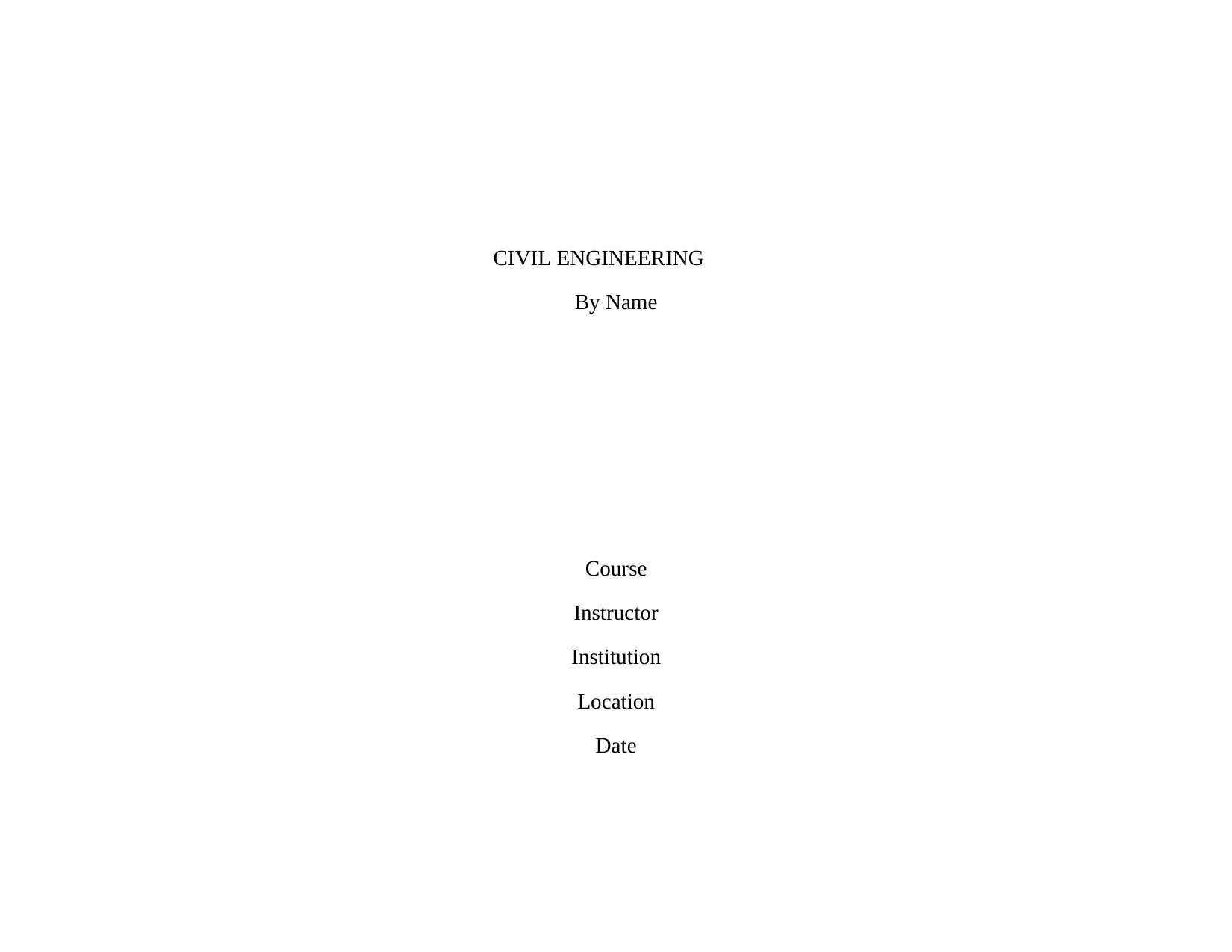
CIVIL ENGINEERING
By Name
Course
Instructor
Institution
Location
Date
By Name
Course
Instructor
Institution
Location
Date
Paraphrase This Document
Need a fresh take? Get an instant paraphrase of this document with our AI Paraphraser
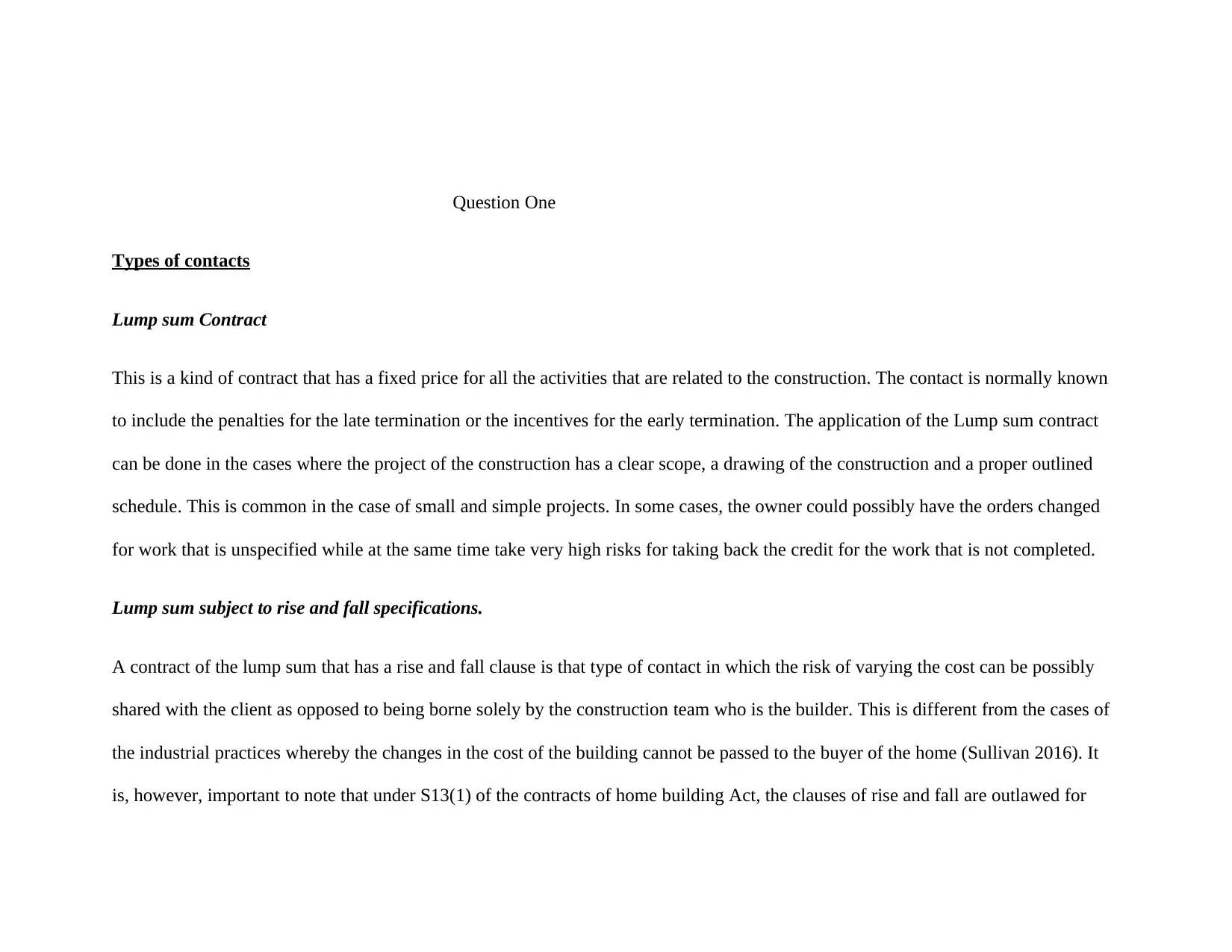
Question One
Types of contacts
Lump sum Contract
This is a kind of contract that has a fixed price for all the activities that are related to the construction. The contact is normally known
to include the penalties for the late termination or the incentives for the early termination. The application of the Lump sum contract
can be done in the cases where the project of the construction has a clear scope, a drawing of the construction and a proper outlined
schedule. This is common in the case of small and simple projects. In some cases, the owner could possibly have the orders changed
for work that is unspecified while at the same time take very high risks for taking back the credit for the work that is not completed.
Lump sum subject to rise and fall specifications.
A contract of the lump sum that has a rise and fall clause is that type of contact in which the risk of varying the cost can be possibly
shared with the client as opposed to being borne solely by the construction team who is the builder. This is different from the cases of
the industrial practices whereby the changes in the cost of the building cannot be passed to the buyer of the home (Sullivan 2016). It
is, however, important to note that under S13(1) of the contracts of home building Act, the clauses of rise and fall are outlawed for
Types of contacts
Lump sum Contract
This is a kind of contract that has a fixed price for all the activities that are related to the construction. The contact is normally known
to include the penalties for the late termination or the incentives for the early termination. The application of the Lump sum contract
can be done in the cases where the project of the construction has a clear scope, a drawing of the construction and a proper outlined
schedule. This is common in the case of small and simple projects. In some cases, the owner could possibly have the orders changed
for work that is unspecified while at the same time take very high risks for taking back the credit for the work that is not completed.
Lump sum subject to rise and fall specifications.
A contract of the lump sum that has a rise and fall clause is that type of contact in which the risk of varying the cost can be possibly
shared with the client as opposed to being borne solely by the construction team who is the builder. This is different from the cases of
the industrial practices whereby the changes in the cost of the building cannot be passed to the buyer of the home (Sullivan 2016). It
is, however, important to note that under S13(1) of the contracts of home building Act, the clauses of rise and fall are outlawed for
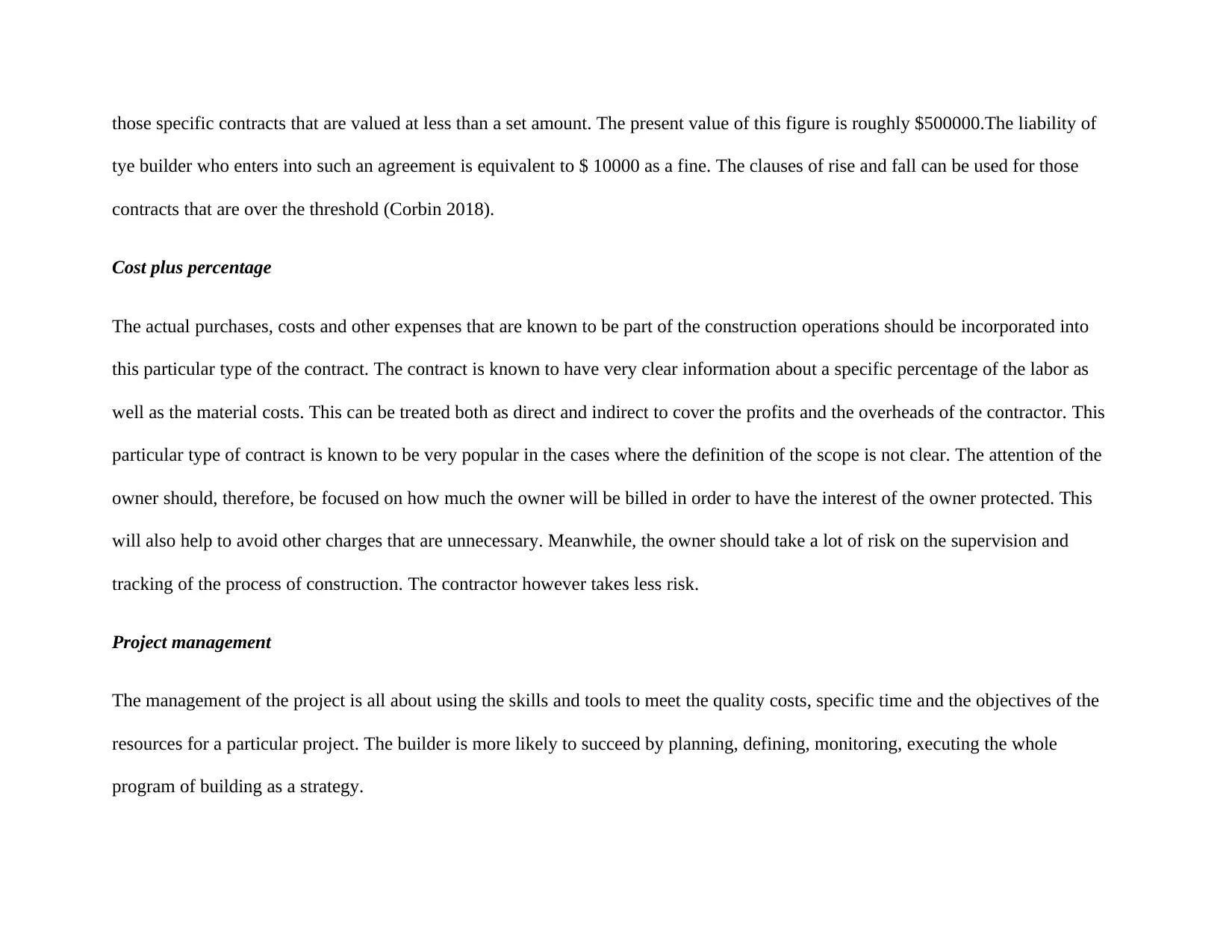
those specific contracts that are valued at less than a set amount. The present value of this figure is roughly $500000.The liability of
tye builder who enters into such an agreement is equivalent to $ 10000 as a fine. The clauses of rise and fall can be used for those
contracts that are over the threshold (Corbin 2018).
Cost plus percentage
The actual purchases, costs and other expenses that are known to be part of the construction operations should be incorporated into
this particular type of the contract. The contract is known to have very clear information about a specific percentage of the labor as
well as the material costs. This can be treated both as direct and indirect to cover the profits and the overheads of the contractor. This
particular type of contract is known to be very popular in the cases where the definition of the scope is not clear. The attention of the
owner should, therefore, be focused on how much the owner will be billed in order to have the interest of the owner protected. This
will also help to avoid other charges that are unnecessary. Meanwhile, the owner should take a lot of risk on the supervision and
tracking of the process of construction. The contractor however takes less risk.
Project management
The management of the project is all about using the skills and tools to meet the quality costs, specific time and the objectives of the
resources for a particular project. The builder is more likely to succeed by planning, defining, monitoring, executing the whole
program of building as a strategy.
tye builder who enters into such an agreement is equivalent to $ 10000 as a fine. The clauses of rise and fall can be used for those
contracts that are over the threshold (Corbin 2018).
Cost plus percentage
The actual purchases, costs and other expenses that are known to be part of the construction operations should be incorporated into
this particular type of the contract. The contract is known to have very clear information about a specific percentage of the labor as
well as the material costs. This can be treated both as direct and indirect to cover the profits and the overheads of the contractor. This
particular type of contract is known to be very popular in the cases where the definition of the scope is not clear. The attention of the
owner should, therefore, be focused on how much the owner will be billed in order to have the interest of the owner protected. This
will also help to avoid other charges that are unnecessary. Meanwhile, the owner should take a lot of risk on the supervision and
tracking of the process of construction. The contractor however takes less risk.
Project management
The management of the project is all about using the skills and tools to meet the quality costs, specific time and the objectives of the
resources for a particular project. The builder is more likely to succeed by planning, defining, monitoring, executing the whole
program of building as a strategy.
⊘ This is a preview!⊘
Do you want full access?
Subscribe today to unlock all pages.

Trusted by 1+ million students worldwide
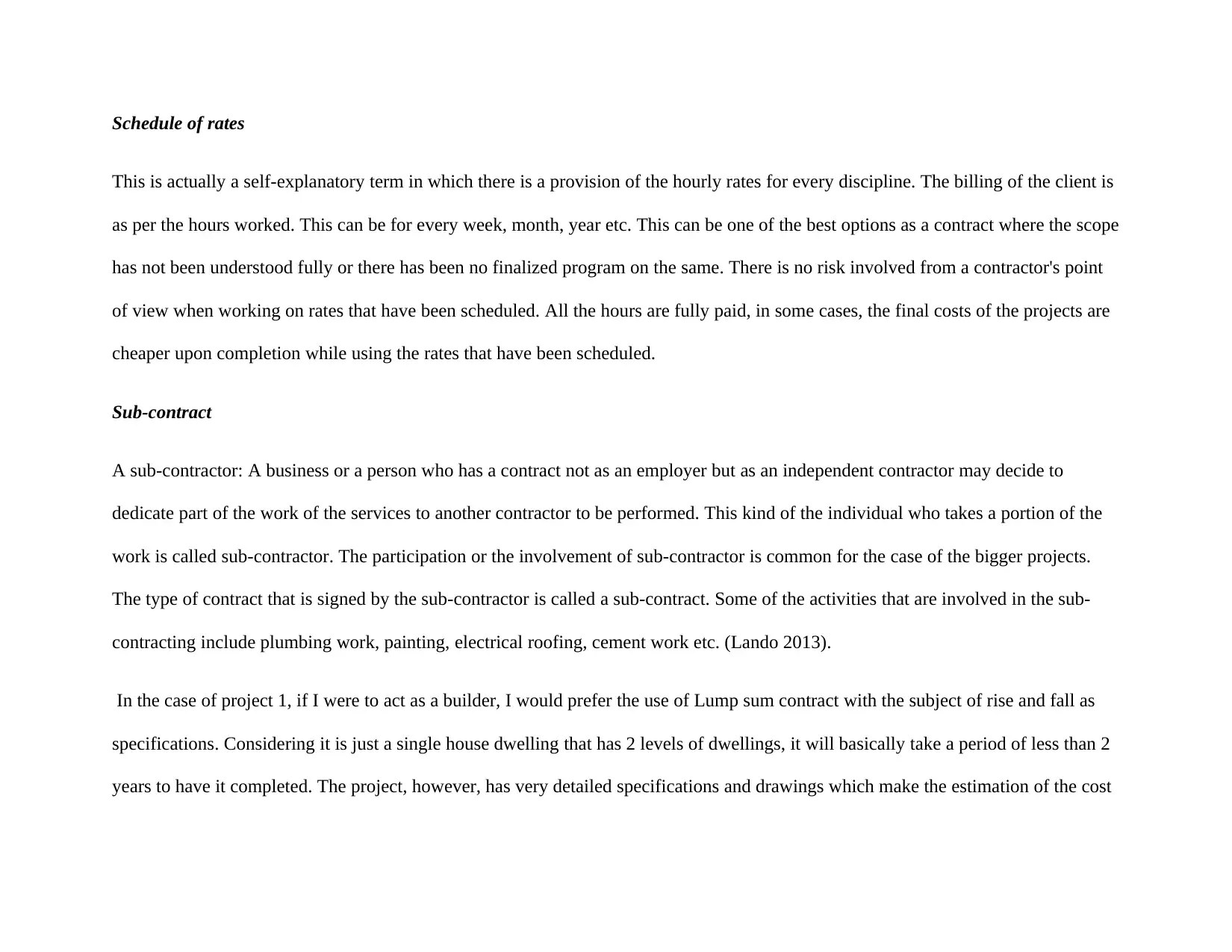
Schedule of rates
This is actually a self-explanatory term in which there is a provision of the hourly rates for every discipline. The billing of the client is
as per the hours worked. This can be for every week, month, year etc. This can be one of the best options as a contract where the scope
has not been understood fully or there has been no finalized program on the same. There is no risk involved from a contractor's point
of view when working on rates that have been scheduled. All the hours are fully paid, in some cases, the final costs of the projects are
cheaper upon completion while using the rates that have been scheduled.
Sub-contract
A sub-contractor: A business or a person who has a contract not as an employer but as an independent contractor may decide to
dedicate part of the work of the services to another contractor to be performed. This kind of the individual who takes a portion of the
work is called sub-contractor. The participation or the involvement of sub-contractor is common for the case of the bigger projects.
The type of contract that is signed by the sub-contractor is called a sub-contract. Some of the activities that are involved in the sub-
contracting include plumbing work, painting, electrical roofing, cement work etc. (Lando 2013).
In the case of project 1, if I were to act as a builder, I would prefer the use of Lump sum contract with the subject of rise and fall as
specifications. Considering it is just a single house dwelling that has 2 levels of dwellings, it will basically take a period of less than 2
years to have it completed. The project, however, has very detailed specifications and drawings which make the estimation of the cost
This is actually a self-explanatory term in which there is a provision of the hourly rates for every discipline. The billing of the client is
as per the hours worked. This can be for every week, month, year etc. This can be one of the best options as a contract where the scope
has not been understood fully or there has been no finalized program on the same. There is no risk involved from a contractor's point
of view when working on rates that have been scheduled. All the hours are fully paid, in some cases, the final costs of the projects are
cheaper upon completion while using the rates that have been scheduled.
Sub-contract
A sub-contractor: A business or a person who has a contract not as an employer but as an independent contractor may decide to
dedicate part of the work of the services to another contractor to be performed. This kind of the individual who takes a portion of the
work is called sub-contractor. The participation or the involvement of sub-contractor is common for the case of the bigger projects.
The type of contract that is signed by the sub-contractor is called a sub-contract. Some of the activities that are involved in the sub-
contracting include plumbing work, painting, electrical roofing, cement work etc. (Lando 2013).
In the case of project 1, if I were to act as a builder, I would prefer the use of Lump sum contract with the subject of rise and fall as
specifications. Considering it is just a single house dwelling that has 2 levels of dwellings, it will basically take a period of less than 2
years to have it completed. The project, however, has very detailed specifications and drawings which make the estimation of the cost
Paraphrase This Document
Need a fresh take? Get an instant paraphrase of this document with our AI Paraphraser
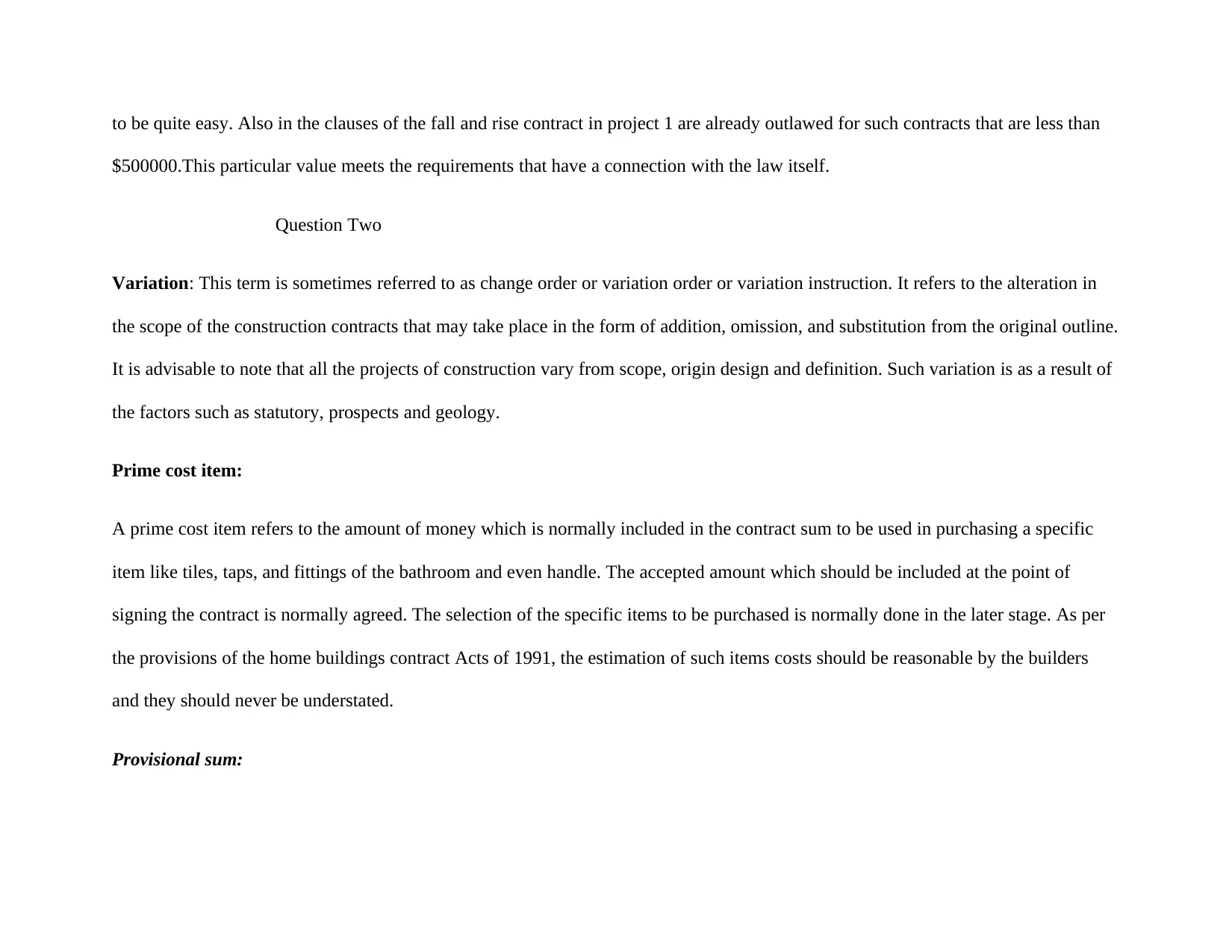
to be quite easy. Also in the clauses of the fall and rise contract in project 1 are already outlawed for such contracts that are less than
$500000.This particular value meets the requirements that have a connection with the law itself.
Question Two
Variation: This term is sometimes referred to as change order or variation order or variation instruction. It refers to the alteration in
the scope of the construction contracts that may take place in the form of addition, omission, and substitution from the original outline.
It is advisable to note that all the projects of construction vary from scope, origin design and definition. Such variation is as a result of
the factors such as statutory, prospects and geology.
Prime cost item:
A prime cost item refers to the amount of money which is normally included in the contract sum to be used in purchasing a specific
item like tiles, taps, and fittings of the bathroom and even handle. The accepted amount which should be included at the point of
signing the contract is normally agreed. The selection of the specific items to be purchased is normally done in the later stage. As per
the provisions of the home buildings contract Acts of 1991, the estimation of such items costs should be reasonable by the builders
and they should never be understated.
Provisional sum:
$500000.This particular value meets the requirements that have a connection with the law itself.
Question Two
Variation: This term is sometimes referred to as change order or variation order or variation instruction. It refers to the alteration in
the scope of the construction contracts that may take place in the form of addition, omission, and substitution from the original outline.
It is advisable to note that all the projects of construction vary from scope, origin design and definition. Such variation is as a result of
the factors such as statutory, prospects and geology.
Prime cost item:
A prime cost item refers to the amount of money which is normally included in the contract sum to be used in purchasing a specific
item like tiles, taps, and fittings of the bathroom and even handle. The accepted amount which should be included at the point of
signing the contract is normally agreed. The selection of the specific items to be purchased is normally done in the later stage. As per
the provisions of the home buildings contract Acts of 1991, the estimation of such items costs should be reasonable by the builders
and they should never be understated.
Provisional sum:
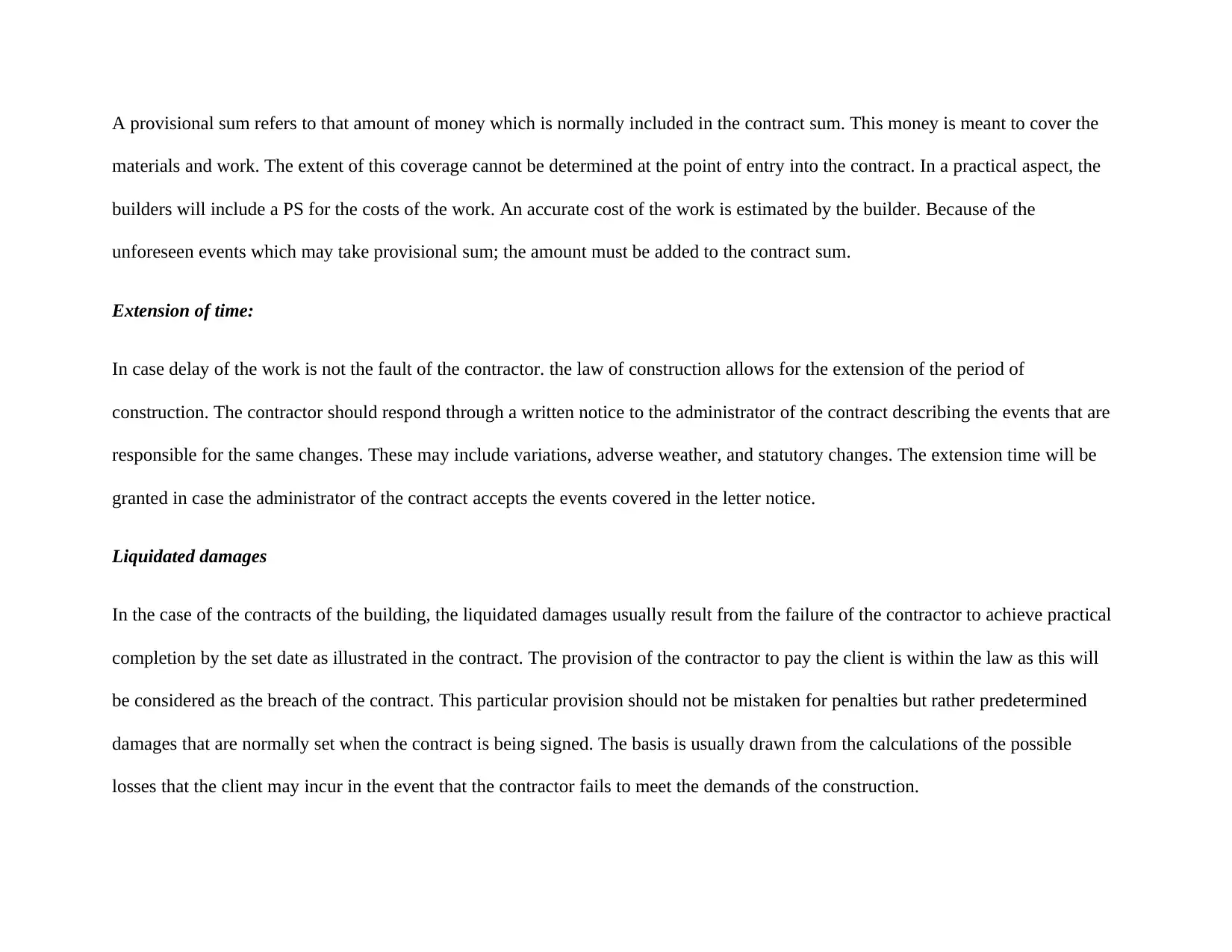
A provisional sum refers to that amount of money which is normally included in the contract sum. This money is meant to cover the
materials and work. The extent of this coverage cannot be determined at the point of entry into the contract. In a practical aspect, the
builders will include a PS for the costs of the work. An accurate cost of the work is estimated by the builder. Because of the
unforeseen events which may take provisional sum; the amount must be added to the contract sum.
Extension of time:
In case delay of the work is not the fault of the contractor. the law of construction allows for the extension of the period of
construction. The contractor should respond through a written notice to the administrator of the contract describing the events that are
responsible for the same changes. These may include variations, adverse weather, and statutory changes. The extension time will be
granted in case the administrator of the contract accepts the events covered in the letter notice.
Liquidated damages
In the case of the contracts of the building, the liquidated damages usually result from the failure of the contractor to achieve practical
completion by the set date as illustrated in the contract. The provision of the contractor to pay the client is within the law as this will
be considered as the breach of the contract. This particular provision should not be mistaken for penalties but rather predetermined
damages that are normally set when the contract is being signed. The basis is usually drawn from the calculations of the possible
losses that the client may incur in the event that the contractor fails to meet the demands of the construction.
materials and work. The extent of this coverage cannot be determined at the point of entry into the contract. In a practical aspect, the
builders will include a PS for the costs of the work. An accurate cost of the work is estimated by the builder. Because of the
unforeseen events which may take provisional sum; the amount must be added to the contract sum.
Extension of time:
In case delay of the work is not the fault of the contractor. the law of construction allows for the extension of the period of
construction. The contractor should respond through a written notice to the administrator of the contract describing the events that are
responsible for the same changes. These may include variations, adverse weather, and statutory changes. The extension time will be
granted in case the administrator of the contract accepts the events covered in the letter notice.
Liquidated damages
In the case of the contracts of the building, the liquidated damages usually result from the failure of the contractor to achieve practical
completion by the set date as illustrated in the contract. The provision of the contractor to pay the client is within the law as this will
be considered as the breach of the contract. This particular provision should not be mistaken for penalties but rather predetermined
damages that are normally set when the contract is being signed. The basis is usually drawn from the calculations of the possible
losses that the client may incur in the event that the contractor fails to meet the demands of the construction.
⊘ This is a preview!⊘
Do you want full access?
Subscribe today to unlock all pages.

Trusted by 1+ million students worldwide

Possession of the site
The law of contracts normally grants the contractor to have exclusive possession of the site of construction until the time of
completion of the project. This will only take place during the handover meeting where the possession of the project is reverted to the
client. In the contract, it may be possible to state the date for this exercise of possession transfer and if that is not done then a
reasonable signing date and time may be sought.
Cooling off period
After the reception of a signed copy, the client has five business days to change his/her mind as far as the building contract is
concerned. This is referred to as the cooling off period. This date starts from the time the client received the signed copy regardless of
the time it was signed. In the event that the contract failed to include notices of cooling off periods, the client has up to seven days
after realigning the contract ought to have included the same notice. Withdrawal by the client from the contract is thus allowed
(Macneil 2017).
Defects liability period:
The period of defects liability starts upon certification of the practical completion. This period will last for a period of about 6 to 12
months. During this particular period, the client will be required to report any defects that may arise to the administrator of the
contracts (Llewellyn 2019). The administrator will be required to confirm whether they are just facts issues of maintenance or they are
The law of contracts normally grants the contractor to have exclusive possession of the site of construction until the time of
completion of the project. This will only take place during the handover meeting where the possession of the project is reverted to the
client. In the contract, it may be possible to state the date for this exercise of possession transfer and if that is not done then a
reasonable signing date and time may be sought.
Cooling off period
After the reception of a signed copy, the client has five business days to change his/her mind as far as the building contract is
concerned. This is referred to as the cooling off period. This date starts from the time the client received the signed copy regardless of
the time it was signed. In the event that the contract failed to include notices of cooling off periods, the client has up to seven days
after realigning the contract ought to have included the same notice. Withdrawal by the client from the contract is thus allowed
(Macneil 2017).
Defects liability period:
The period of defects liability starts upon certification of the practical completion. This period will last for a period of about 6 to 12
months. During this particular period, the client will be required to report any defects that may arise to the administrator of the
contracts (Llewellyn 2019). The administrator will be required to confirm whether they are just facts issues of maintenance or they are
Paraphrase This Document
Need a fresh take? Get an instant paraphrase of this document with our AI Paraphraser
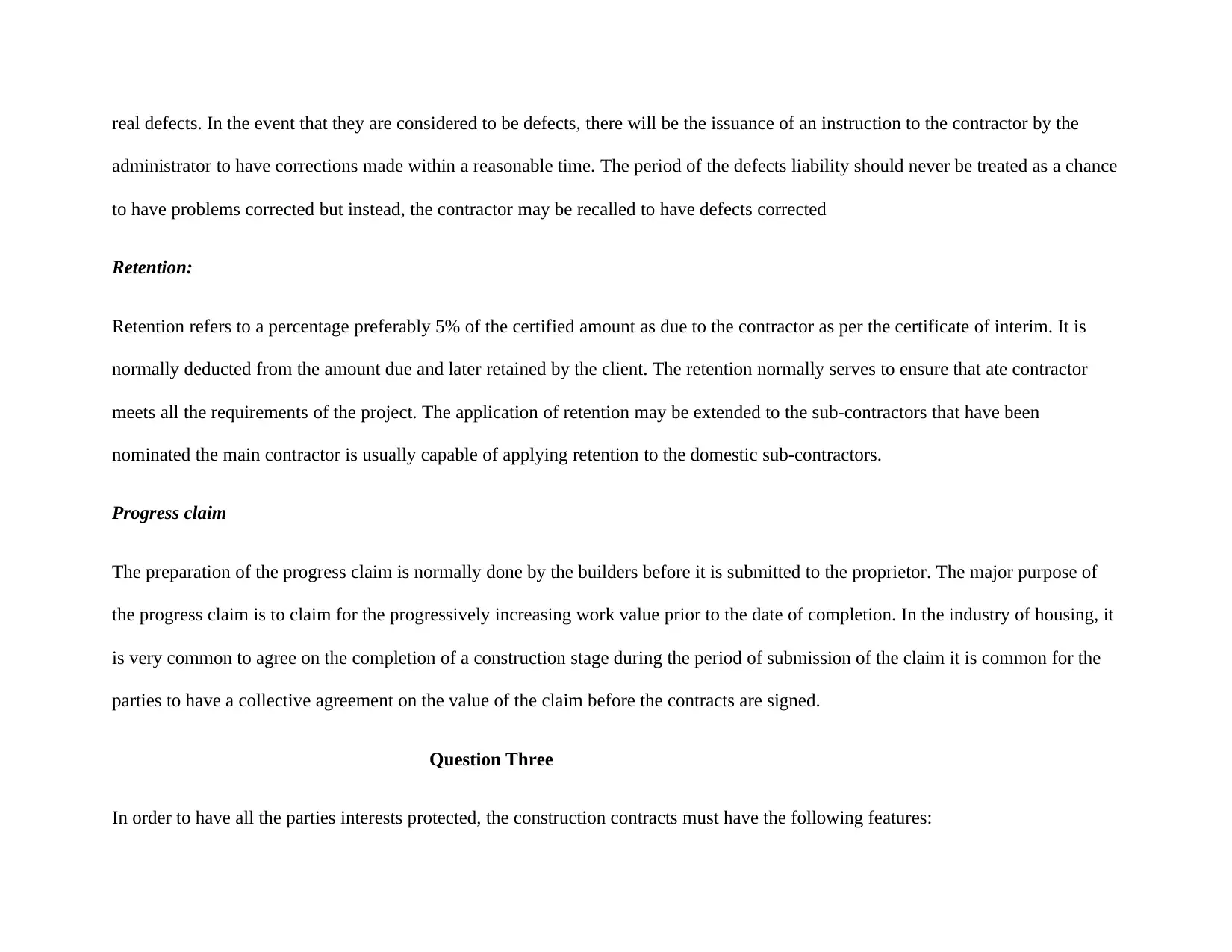
real defects. In the event that they are considered to be defects, there will be the issuance of an instruction to the contractor by the
administrator to have corrections made within a reasonable time. The period of the defects liability should never be treated as a chance
to have problems corrected but instead, the contractor may be recalled to have defects corrected
Retention:
Retention refers to a percentage preferably 5% of the certified amount as due to the contractor as per the certificate of interim. It is
normally deducted from the amount due and later retained by the client. The retention normally serves to ensure that ate contractor
meets all the requirements of the project. The application of retention may be extended to the sub-contractors that have been
nominated the main contractor is usually capable of applying retention to the domestic sub-contractors.
Progress claim
The preparation of the progress claim is normally done by the builders before it is submitted to the proprietor. The major purpose of
the progress claim is to claim for the progressively increasing work value prior to the date of completion. In the industry of housing, it
is very common to agree on the completion of a construction stage during the period of submission of the claim it is common for the
parties to have a collective agreement on the value of the claim before the contracts are signed.
Question Three
In order to have all the parties interests protected, the construction contracts must have the following features:
administrator to have corrections made within a reasonable time. The period of the defects liability should never be treated as a chance
to have problems corrected but instead, the contractor may be recalled to have defects corrected
Retention:
Retention refers to a percentage preferably 5% of the certified amount as due to the contractor as per the certificate of interim. It is
normally deducted from the amount due and later retained by the client. The retention normally serves to ensure that ate contractor
meets all the requirements of the project. The application of retention may be extended to the sub-contractors that have been
nominated the main contractor is usually capable of applying retention to the domestic sub-contractors.
Progress claim
The preparation of the progress claim is normally done by the builders before it is submitted to the proprietor. The major purpose of
the progress claim is to claim for the progressively increasing work value prior to the date of completion. In the industry of housing, it
is very common to agree on the completion of a construction stage during the period of submission of the claim it is common for the
parties to have a collective agreement on the value of the claim before the contracts are signed.
Question Three
In order to have all the parties interests protected, the construction contracts must have the following features:
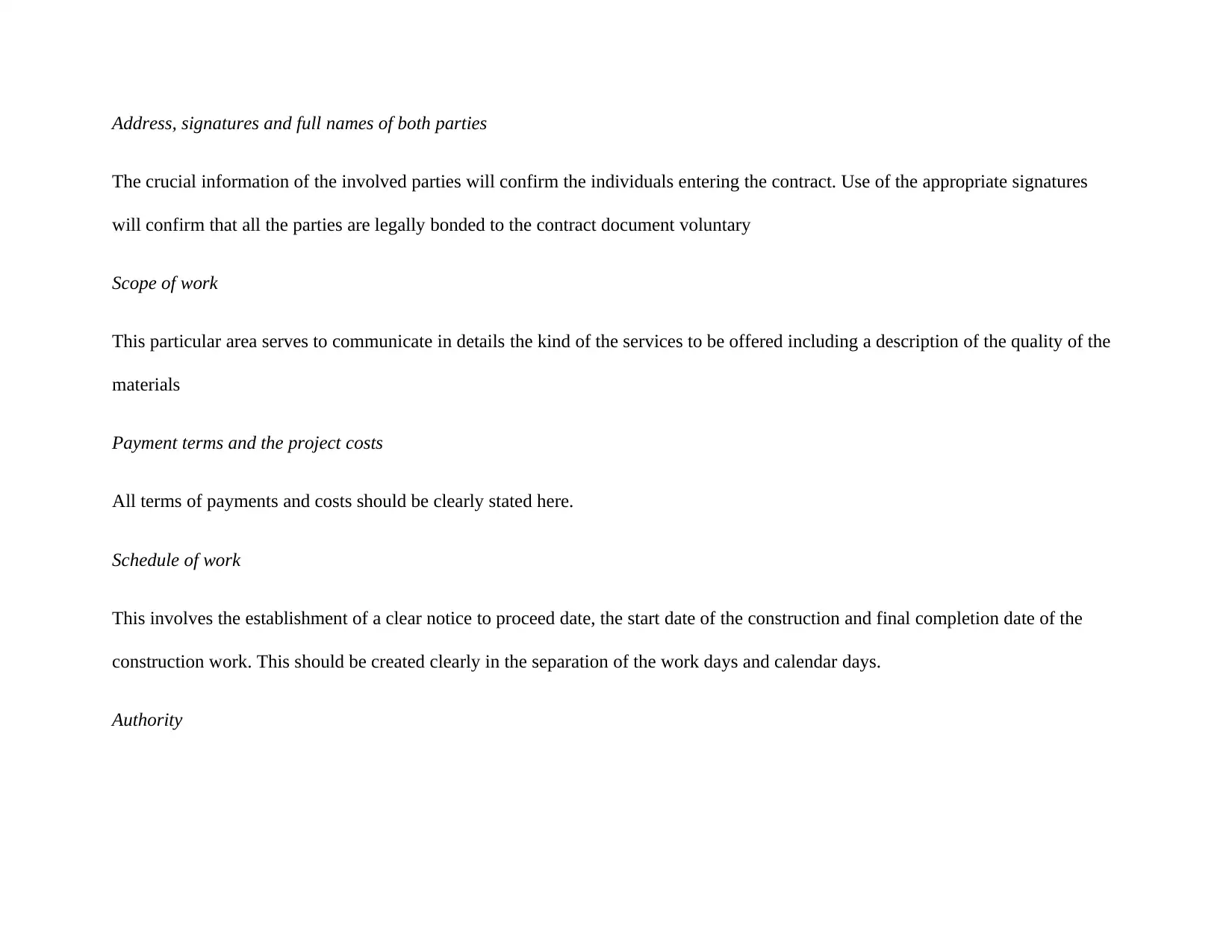
Address, signatures and full names of both parties
The crucial information of the involved parties will confirm the individuals entering the contract. Use of the appropriate signatures
will confirm that all the parties are legally bonded to the contract document voluntary
Scope of work
This particular area serves to communicate in details the kind of the services to be offered including a description of the quality of the
materials
Payment terms and the project costs
All terms of payments and costs should be clearly stated here.
Schedule of work
This involves the establishment of a clear notice to proceed date, the start date of the construction and final completion date of the
construction work. This should be created clearly in the separation of the work days and calendar days.
Authority
The crucial information of the involved parties will confirm the individuals entering the contract. Use of the appropriate signatures
will confirm that all the parties are legally bonded to the contract document voluntary
Scope of work
This particular area serves to communicate in details the kind of the services to be offered including a description of the quality of the
materials
Payment terms and the project costs
All terms of payments and costs should be clearly stated here.
Schedule of work
This involves the establishment of a clear notice to proceed date, the start date of the construction and final completion date of the
construction work. This should be created clearly in the separation of the work days and calendar days.
Authority
⊘ This is a preview!⊘
Do you want full access?
Subscribe today to unlock all pages.

Trusted by 1+ million students worldwide
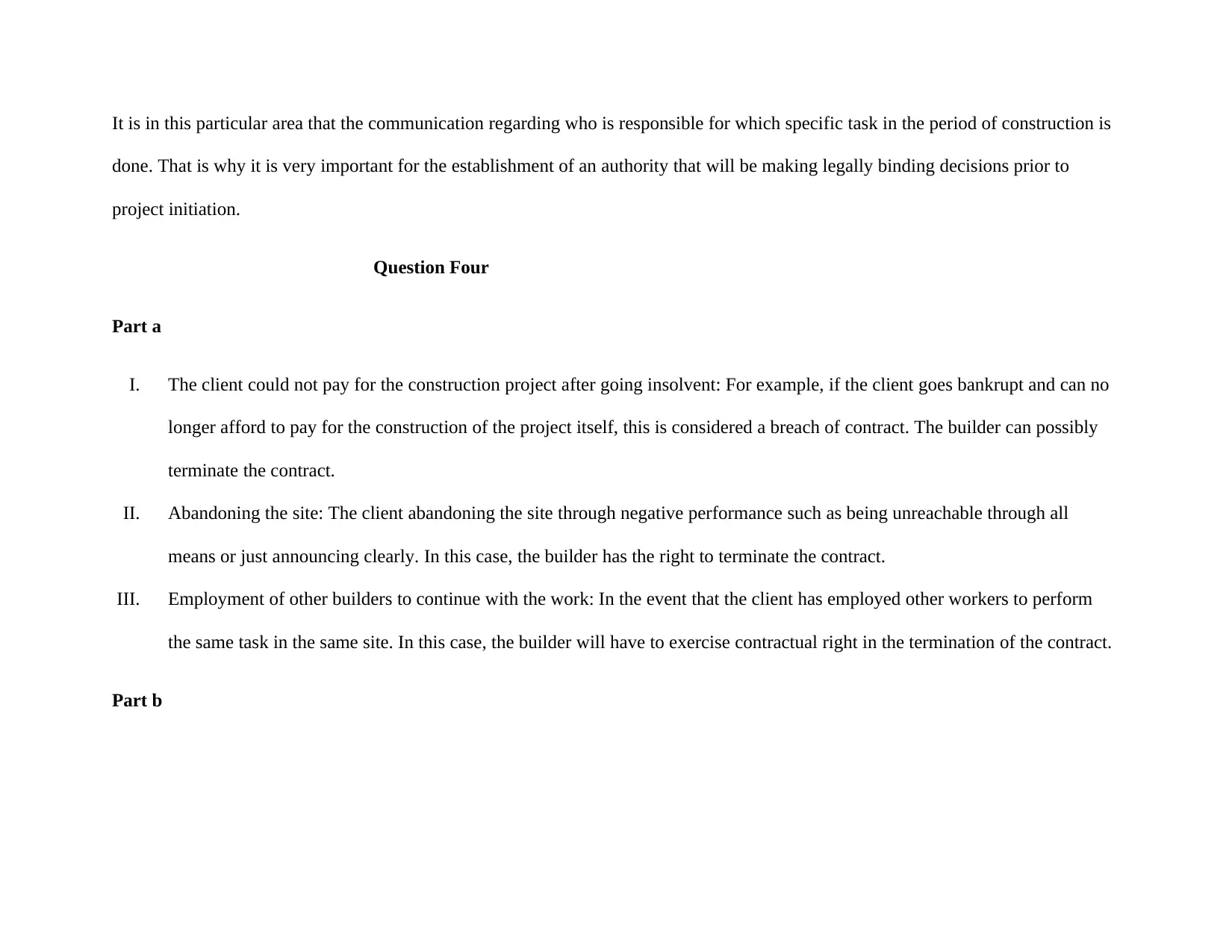
It is in this particular area that the communication regarding who is responsible for which specific task in the period of construction is
done. That is why it is very important for the establishment of an authority that will be making legally binding decisions prior to
project initiation.
Question Four
Part a
I. The client could not pay for the construction project after going insolvent: For example, if the client goes bankrupt and can no
longer afford to pay for the construction of the project itself, this is considered a breach of contract. The builder can possibly
terminate the contract.
II. Abandoning the site: The client abandoning the site through negative performance such as being unreachable through all
means or just announcing clearly. In this case, the builder has the right to terminate the contract.
III. Employment of other builders to continue with the work: In the event that the client has employed other workers to perform
the same task in the same site. In this case, the builder will have to exercise contractual right in the termination of the contract.
Part b
done. That is why it is very important for the establishment of an authority that will be making legally binding decisions prior to
project initiation.
Question Four
Part a
I. The client could not pay for the construction project after going insolvent: For example, if the client goes bankrupt and can no
longer afford to pay for the construction of the project itself, this is considered a breach of contract. The builder can possibly
terminate the contract.
II. Abandoning the site: The client abandoning the site through negative performance such as being unreachable through all
means or just announcing clearly. In this case, the builder has the right to terminate the contract.
III. Employment of other builders to continue with the work: In the event that the client has employed other workers to perform
the same task in the same site. In this case, the builder will have to exercise contractual right in the termination of the contract.
Part b
Paraphrase This Document
Need a fresh take? Get an instant paraphrase of this document with our AI Paraphraser

i. The original scope of the work has been changed by the builder: In the period of the construction, the builder has not followed
the drawing that has been provided by the clients. For example, the builder may decide to change the scope of the work thus
breaching the contract and the client can possibly terminate the contract
ii. Failure to rectify or remove a defective work: For example, the builder deliberately refuses to fix a tile ceiling that has been
wrongly installed in the public area. In this case, the client will have all the rights to terminate the contract.
iii. A significant delay in the project completion and cause of bigger damages: The builder predicts to finish the project for a long
time that the client is not willing to wait or the builder could not complete the project in time without reasonable causes.
Question Five
All documents
Instruction forms: This particular form contains the instructions that have been issued by the architecture.
Time of extension Claim: Ideally the contracts of the construction have specific provisions that entitle the contractor to
extension of time in the event of occurrence of a particular event which consequently leads to the delay of the work. In case the
responsibility rest with the employer like force majeure or very harsh conditions of the climate, the contractor will be entitled
to a time extension. This, however, will be dependent on the specific conditions and terms of the contracts. In the cases where
the contractor is responsible for the messes then the responsibilities rest with the contractor himself.
the drawing that has been provided by the clients. For example, the builder may decide to change the scope of the work thus
breaching the contract and the client can possibly terminate the contract
ii. Failure to rectify or remove a defective work: For example, the builder deliberately refuses to fix a tile ceiling that has been
wrongly installed in the public area. In this case, the client will have all the rights to terminate the contract.
iii. A significant delay in the project completion and cause of bigger damages: The builder predicts to finish the project for a long
time that the client is not willing to wait or the builder could not complete the project in time without reasonable causes.
Question Five
All documents
Instruction forms: This particular form contains the instructions that have been issued by the architecture.
Time of extension Claim: Ideally the contracts of the construction have specific provisions that entitle the contractor to
extension of time in the event of occurrence of a particular event which consequently leads to the delay of the work. In case the
responsibility rest with the employer like force majeure or very harsh conditions of the climate, the contractor will be entitled
to a time extension. This, however, will be dependent on the specific conditions and terms of the contracts. In the cases where
the contractor is responsible for the messes then the responsibilities rest with the contractor himself.
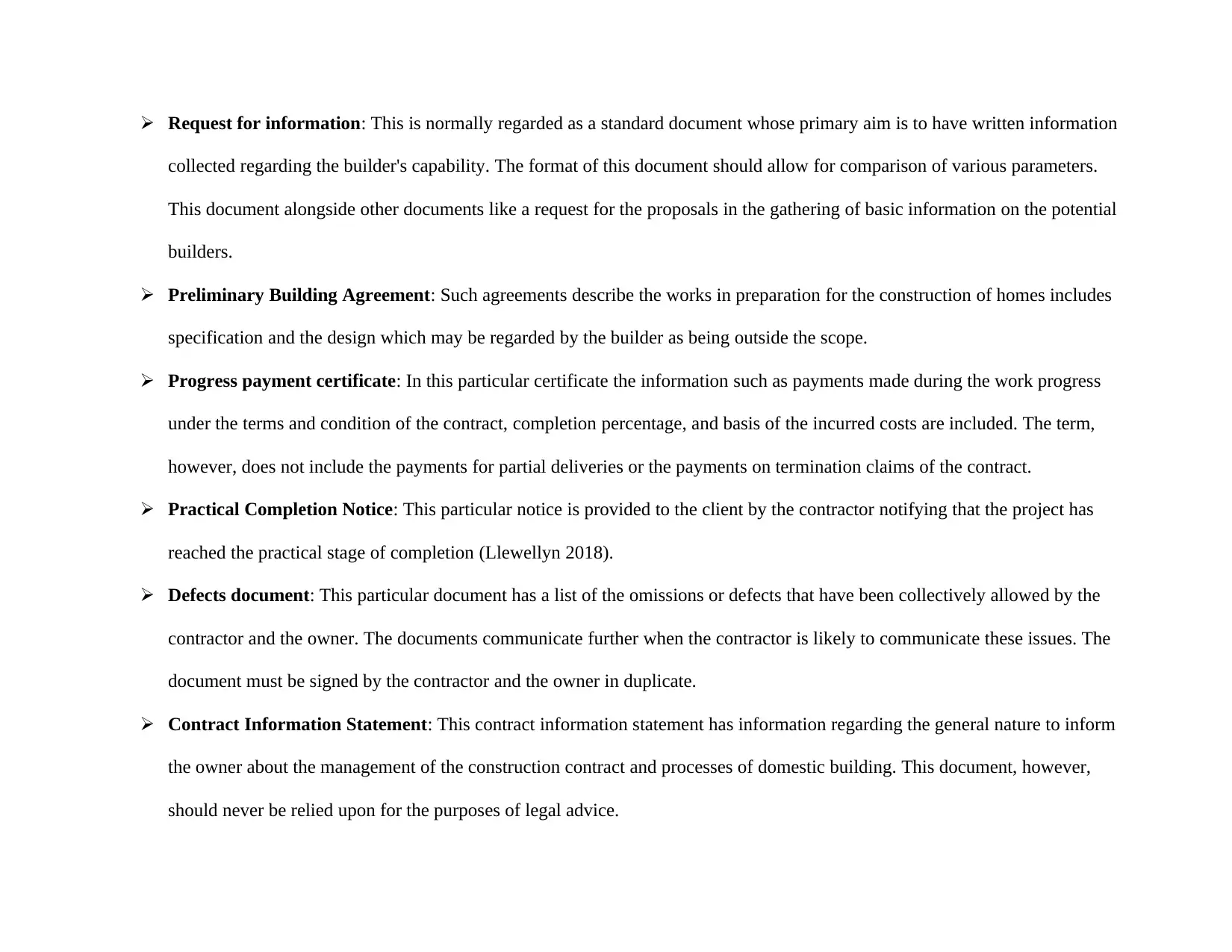
Request for information: This is normally regarded as a standard document whose primary aim is to have written information
collected regarding the builder's capability. The format of this document should allow for comparison of various parameters.
This document alongside other documents like a request for the proposals in the gathering of basic information on the potential
builders.
Preliminary Building Agreement: Such agreements describe the works in preparation for the construction of homes includes
specification and the design which may be regarded by the builder as being outside the scope.
Progress payment certificate: In this particular certificate the information such as payments made during the work progress
under the terms and condition of the contract, completion percentage, and basis of the incurred costs are included. The term,
however, does not include the payments for partial deliveries or the payments on termination claims of the contract.
Practical Completion Notice: This particular notice is provided to the client by the contractor notifying that the project has
reached the practical stage of completion (Llewellyn 2018).
Defects document: This particular document has a list of the omissions or defects that have been collectively allowed by the
contractor and the owner. The documents communicate further when the contractor is likely to communicate these issues. The
document must be signed by the contractor and the owner in duplicate.
Contract Information Statement: This contract information statement has information regarding the general nature to inform
the owner about the management of the construction contract and processes of domestic building. This document, however,
should never be relied upon for the purposes of legal advice.
collected regarding the builder's capability. The format of this document should allow for comparison of various parameters.
This document alongside other documents like a request for the proposals in the gathering of basic information on the potential
builders.
Preliminary Building Agreement: Such agreements describe the works in preparation for the construction of homes includes
specification and the design which may be regarded by the builder as being outside the scope.
Progress payment certificate: In this particular certificate the information such as payments made during the work progress
under the terms and condition of the contract, completion percentage, and basis of the incurred costs are included. The term,
however, does not include the payments for partial deliveries or the payments on termination claims of the contract.
Practical Completion Notice: This particular notice is provided to the client by the contractor notifying that the project has
reached the practical stage of completion (Llewellyn 2018).
Defects document: This particular document has a list of the omissions or defects that have been collectively allowed by the
contractor and the owner. The documents communicate further when the contractor is likely to communicate these issues. The
document must be signed by the contractor and the owner in duplicate.
Contract Information Statement: This contract information statement has information regarding the general nature to inform
the owner about the management of the construction contract and processes of domestic building. This document, however,
should never be relied upon for the purposes of legal advice.
⊘ This is a preview!⊘
Do you want full access?
Subscribe today to unlock all pages.

Trusted by 1+ million students worldwide
1 out of 27
Related Documents
Your All-in-One AI-Powered Toolkit for Academic Success.
+13062052269
info@desklib.com
Available 24*7 on WhatsApp / Email
![[object Object]](/_next/static/media/star-bottom.7253800d.svg)
Unlock your academic potential
Copyright © 2020–2025 A2Z Services. All Rights Reserved. Developed and managed by ZUCOL.





